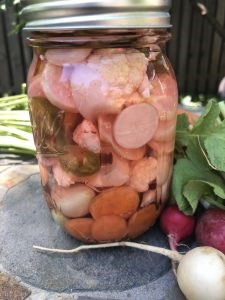This content was originally published by the Longmont Observer and is licensed under a Creative Commons license.
Written by Anne Quinn Corr
The Saturday Longmont farmers market is open now with an abundance of spring vegetables like radishes, green garlic, and asparagus. A valuable member of the cruciferous vegetable family related to mustards, radishes, those cheerful red orbs are ready to brighten our first al fresco dinners.
Oh, radishes, you sigh, those stalwarts of the crudite platter, often carved, badly, into rosettes. How dull. But if your radish exposure is limited to the bagged radishes that are available year round with their tops lopped off, try some fresh from a garden with their greens still attached and you will have a different opinion. This is the time of year for the radish to rule.
Raphanus sativus has a diverse and long history, with roots in the ancient Mediterranean where it was cultivated in Egypt, Greece and Rome. The radish was lauded by the Roman poet Horace, who lived just before the time of Christ, as a vegetable “to excite the languid stomach” and is to this day used as an appetite stimulant on vegetable platters. The leaves are also edible, either raw or cooked, and the vegetable’s familiar spiciness can be tamed by brief cooking.
In this country there are three predominant types of radish that mark different points of the growing season—in the spring, the red globe radishes are one of the first vegetables of the new planting season to appear. In summer, white icicle radishes grow to 6 inches in length and can tolerate warmer weather. In the fall, black radish and daikon are the giant radish cousins, with penetrating heat and longer storage capacities.
The “heat” in a radish is located in the skin, in enzymes that create pungent mustard oils. Peeling a red globe radish tames the heat, but gets rid of the beautiful anthocyanin pigments that are valuable as well. Radish heat is not the same as the tongue-numbing and lip-burning capsaicin fire of hot peppers, but more like a tingly sinus-clearing stimulant that makes you wrinkle your nose.
When purchasing radishes, look for ones that are one to one and a half inches in diameter. Larger than that, they tend to get pithy. If you plan to use them that day or the next, keep the tops on. Otherwise, trim the tops to use separately and the radishes will keep for a longer time. The greens on the radishes should be crisp and bright and make a delicious soup cooked in some vegetable stock and pureed. Don’t trim the fine roots, if there are any, until just before you use them.

My French friend Nathalie Fraisse made me my first spring radish sandwich on slices of baguette slathered with sweet butter, the thinly sliced radishes adorned with a sprinkle of fleur de sel sea salt. The radish sandwich is a spring staple and delicious at breakfast.
Now’s the time to welcome the farmers back to the market and to start enjoying the seasonal produce that will escalate each week in variety and flavor.
Here’s a couple of ways to enjoy radishes this season—the French way, or in a quick refrigerator pickle.
Quick Pickles

For each batch (one wide mouth quart jar) choose about one pound of washed and trimmed vegetables:
- Radishes
- Japanese turnips
- Baby carrots
- Cauliflower florets
For the brine:
Optional spices: one teaspoon of your choice--mustard seed, coriander seed, dill seed, fennel seed, chile flakes
- 1 teaspoon whole black peppercorns
- 1 and one fourth cups cider vinegar
- Three fourths cup water
- One fourth cup granulated sugar
- 1-2 tablespoons Kosher salt, depending on your salt preference
- 1 bay leaf, fresh if possible
Pack your chosen vegetable tightly in a 1-quart glass jar, leaving about 1/2 inch of room at the top. Set aside.
Make the brine: Toast the seeds and peppercorns in a small saucepan over medium heat until fragrant, about 2 minutes. Add the remaining ingredients and stir until the sugar and salt have dissolved. Bring to a boil.
Immediately pour the hot brine into the jar, making sure to cover the vegetables completely. Allow the mixture to cool to room temperature, about 1 hour. Seal the jar with a tightfitting lid and shake or rotate it to evenly distribute the brine and spices. Store in the refrigerator for at least 1 day and preferably 1 week before using. The pickles can be kept in the refrigerator for up to 1 month.
Adapted from http://www.chow.com/recipes/30422-easy-quick-pickles
Anne Quinn Corr is a new volunteer contributor to the Longmont Observer. A long time food writer in her home state of Pennsylvania, portions of this article previously appeared in the Centre Daily Times, a newspaper in State College, PA, and appear with permission.


